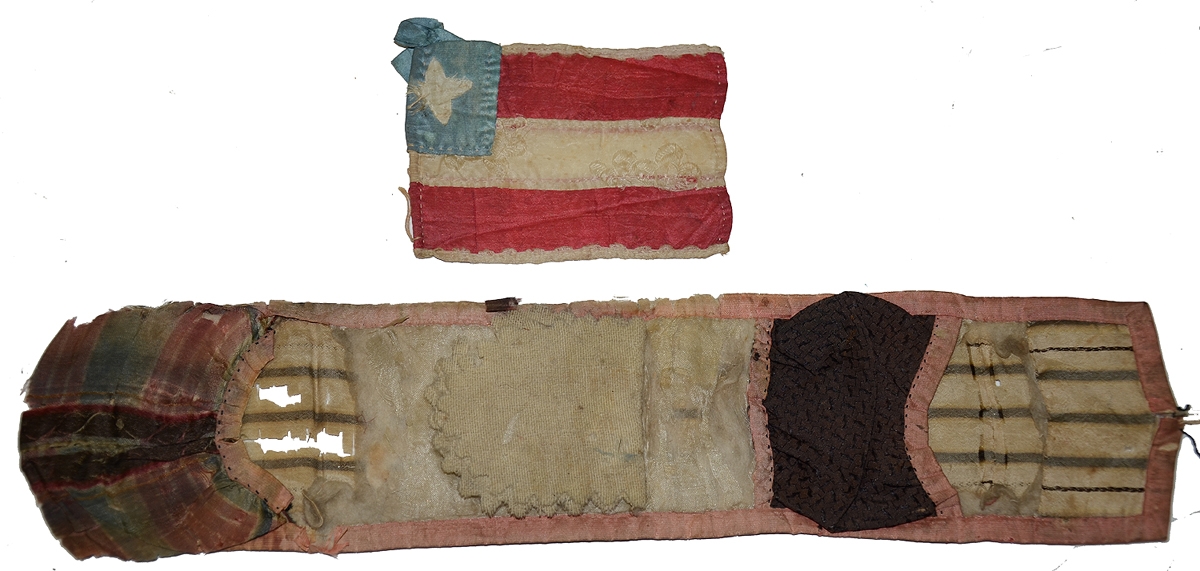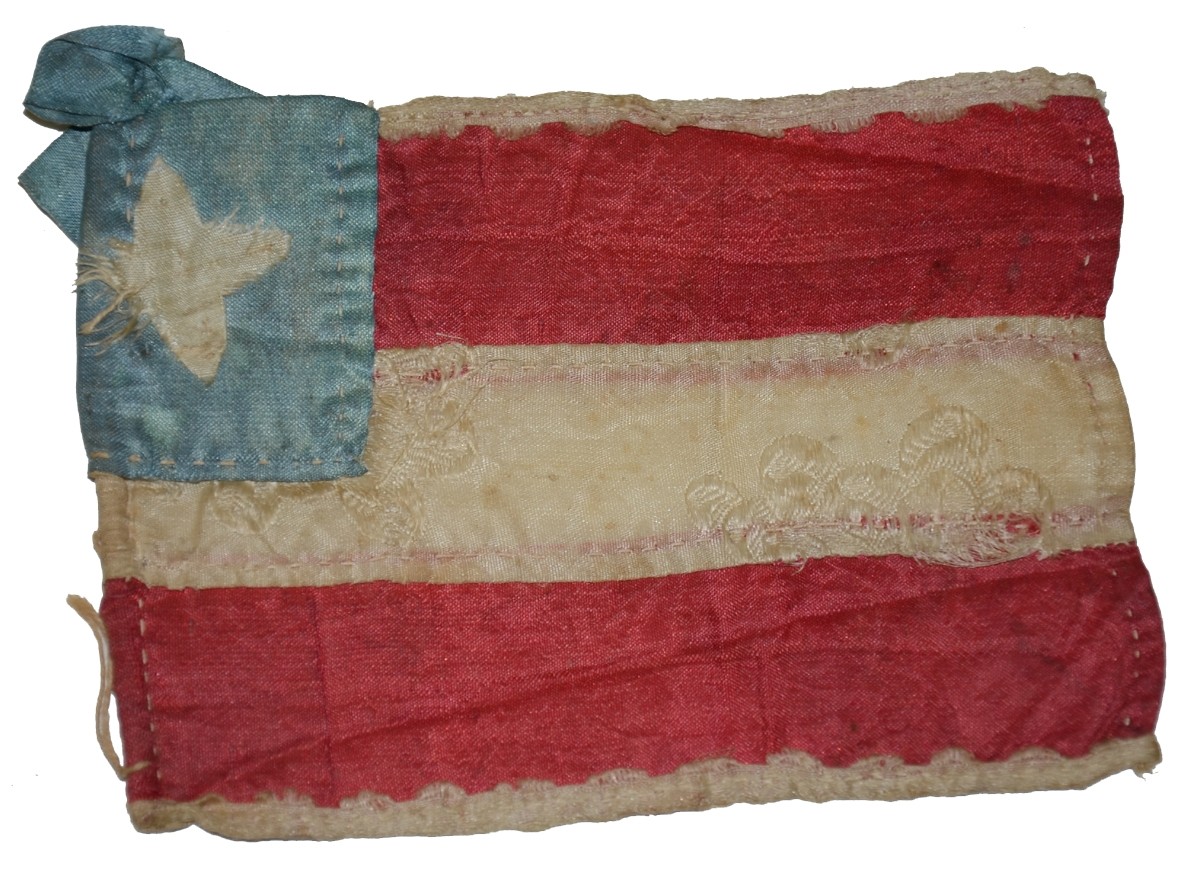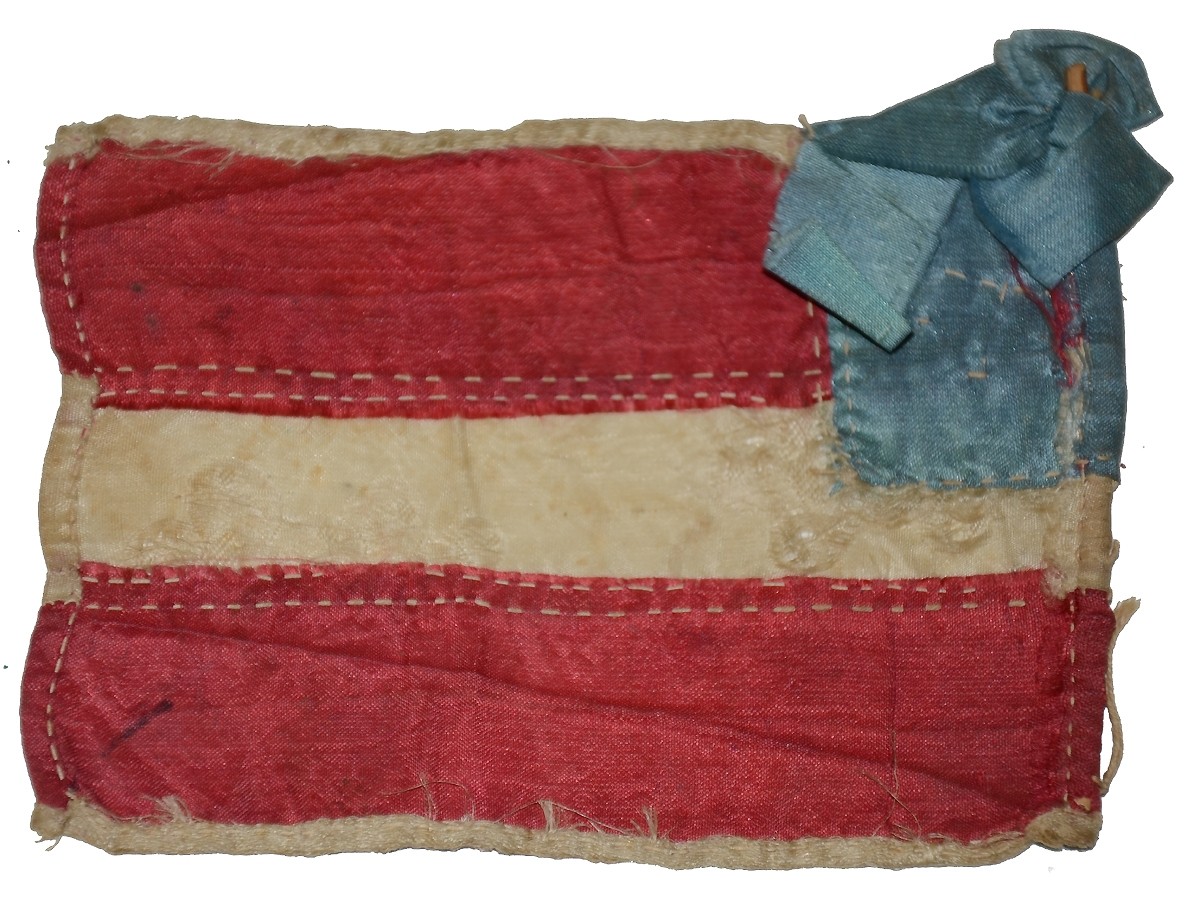site search
online catalog
CONFEDERATE TEXAS BIBLE FLAG AND SOLDIER’S HOUSEWIFE

Hover to zoom





$2,250.00 SOLD
Quantity Available: None
Item Code: 766-942
Small, hand-sewn Confederate flags like this are a collecting category of their own and are called “bible flags” for several reasons. They could be enclosed in bibles given to departing soldiers as reminders of duty to God and country, much like the like the printed presentations pasted inside bibles given to northern soldiers. They also show up preserved in family bibles, for the prosaic purpose of a patriotic bookmark and as keepsakes and reminders to pray for a patriotic defender. After the war, the ever-present family bible was also a proper and discreet place to keep a revered memento of the “lost cause.”
They were also used as early-war secession badges and ours shows signs it served that purpose as well. Measuring about 2 ½ by 3 ½ inches, and intended to be seen from only one side, the small flag has a delicate sleeve at the “hoist” edge that still holds a short portion of a thin stick that was used either to keep it in a buttonhole or more likely to suspend it on two short, tasseled strings from a button or buttonhole. The delicate blue silk canton, with a single white star, is also connected to a small blue bow, reminiscent of the light blue southern secession cockades. The stitching is delicate, if somewhat cursory in joining the stripes. The edges of the flag, however, have been carefully bound. Adding greatly to the charm and significance of the flag is its use of a white brocade fabric for the center stripe. Collectors and students are familiar with accounts of patriotic southern women sacrificing dresses for the cause. Here is a perfect example.
The three red and white stripes are an element used in the Confederate First National Flag. In this case, the canton consists of a single star on a blue ground. First used as a symbol of rebellion against Spanish rule in Florida, the motif spread west to Louisiana and eventually to Texas, where it was adopted as the first Texas national flag in 1836 and was used as the canton of a flag with thirteen red and white stripes by the Texas navy. The use of a star shows up associated with Mississippi in the Civil War as well, but the strongest association remains with Texas, as may be seen in its use as the flag of the 3rd Texas Cavalry, sold at Heritage Auctions in 2007. In this case, the maker adapted it to the first national flag of the Confederacy much as the Texas navy did with the U.S. flag 25 years before.
With this this flag is another example of sewing intended to aid the war effort: a soldier’s roll-up sewing kit, known in camp as a soldier’s “housewife.” Constructed of scrap fabric, this has a long, striped body 2 ½ inches wide and about 12 ¼” inches long. A pocket is positioned at either held to hold buttons, thread, and the like. A small pincushion and cloth leaves are there for pins and needles as well. One end shows small bits of string or cord that would have tied it. These were very common gifts to departing soldiers from mothers, sisters, wives, girlfriends and generally patriotic ladies of the community.
This is a nice pair of Civil War southern homefront contributions to the war effort: one patriotic and symbolic, and the other very practical. They display very well as personal effects and are also reminders of the importance of patriotic support from the southern home-front for the war effort. [sr]
~~~~~~~~~~~~~~~~~~~~~~~~~~~~~~~~~~~
THIS ITEM, AS WITH ALL OTHER ITEMS AVAILABLE ON OUR WEB SITE,
MAY BE PURCHASED THROUGH OUR LAYAWAY PROGRAM.
FOR OUR POLICIES AND TERMS,
CLICK ON ‘CONTACT US’ AT THE TOP OF ANY PAGE ON THE SITE,
THEN ON ‘LAYAWAY POLICY’.
THANK YOU!
Inquire About CONFEDERATE TEXAS BIBLE FLAG AND SOLDIER’S HOUSEWIFE
Most Popular
Historical Firearms Stolen From The National Civil War Museum In Harrisburg, Pa »
Theft From Gravesite Of Gen. John Reynolds »
Selection Of Unframed Prints By Don Troiani »
Fine Condition Brass Infantry Bugle Insignia »
British Imported, Confederate Used Bayonet »
Scarce New Model 1865 Sharps Still In Percussion Near Factory New »
featured item
REMARKABLE SWORD IDENTIFIED TO GEORGE WILLIAM GORDON (1801-1877), US CONSUL TO BRAZIL (1840-46) AND SLAVE TRADE OPPONENT
A remarkable sword manufactured by W.H. Horstmann & Co., New York after the Model 1834 US Revenue Cutter/Marine sword. Neatly engraved on the reverse folding guard, “Geo. Wm. Gordon / United States Consul”. Born on February 8, 1801 in Exeter,… (870-60). Learn More »


